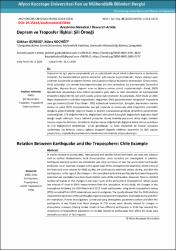Deprem ve troposfer ilişkisi: Şili örneği
Citation
Gürbüz, G. & Koçyiğit, K. (2020). Deprem ve Troposfer İlişkisi: Şili Örneği . Afyon Kocatepe Üniversitesi Fen Ve Mühendislik Bilimleri Dergisi , 20 (6) , 1014-1023 . DOI: 10.35414/akufemubid.823640Abstract
Depremler ile ilgili yapılan çalışmalarda yer ve uydu tabanlı birçok teknik kullanılmakta ve deplasman
miktarları, fay karakteristikleri, gerilim aktarımları gibi konular araştırılmaktadır. Ayrıca, deprem uyarı
sistemleri kurulmakta ve deprem tahmini konusunda tüm Dünya’da adımlar atılmaktadır. Örnek olarak;
GNSS çalışmaları için önemli hata kaynaklarından biri olan atmosferin üst katmanındaki (iyonosfer)
değişimler, deprem öncesi, deprem sırası ve deprem sonrası sürekli incelenmektedir. Ancak, GNSS
ölçümlerinde oluşturduğu hata miktarı iyonosfere göre daha az olan atmosferin alt katmanındaki
(troposfer) değişimler ile ilgili sınırlı sayıda çalışma bulunmaktadır. Bu çalışmada, 2010 Maule ve 2015
Illapel depremlerinin ardından troposferdeki değişimler, GNSS gözlemlerinden hesaplanan troposferik
zenit gecikmeleri (Zenith Total Delay - ZTD) kullanılarak incelenmiştir. Sonuçlar, depremlerin merkez
üssüne en yakın GNSS istasyonlarında, ana şok sırasında ve sonrasında ciddi troposferik anomaliler
olduğunu göstermektedir. Deprem öncesi ve deprem sonrasındaki günlerde atmosferik parametreler
incelendiğinde, ZTD değerlerindeki bu değişimlerin atmosferik basınçtaki değişimlerle doğrudan ilişkili
olduğu tespit edilmiştir. Nazca tektonik plakasının Güney Amerika plakasının altına doğru hareketi
sonucu oluşan fay kırılması, atmosferde ölçülen basınç değerlerinde değişime sebep olmuş ve dolayısı
ile ZTD değişimlerini tetiklemiştir. Şili’de gerçekleşen iki farklı depremde de benzer sonuçlara
rastlanması, fay kırılması sonucu çalışma bölgesini düşeyde etkileyen depremler ile ilgili yapılan
çalışmalarda, troposferik parametrelerin incelenmesinin önemini ortaya çıkarmıştır. In studies related to earthquakes, many ground and satellite-based techniques are used and subjects
such as surface displacements, fault characteristics, stress transfers are investigated. In addition,
earthquake warning systems are established and steps are taken all over the world about earthquake
prediction. As an example, changes in the upper layer of the atmosphere (ionosphere), which is one of
the important error sources for GNSS studies, are continuously examined before, during, and after the
earthquakes. In this regard, the changes in the ionosphere before the earthquake have been frequently
examined and anomalies have been found before some of the earthquakes. However, there is a limited
number of studies on the changes in the lower layer of the atmosphere (troposphere), which causes
less amount of error in GNSS measurements than the ionosphere. In this study, the changes in the
troposphere following the 2010 Maule and 2015 Illapel earthquakes, using zenith tropospheric delays
(ZTD) calculated from GNSS observations, were investigated. The results showed that the GNSS stations
closest to the epicenter of the earthquakes experienced severe tropospheric anomalies during and after
the mainshock. Further investigations carried out using atmospheric parameters before and after the
earthquake, it was found that these changes in ZTD values were directly related to changes in
atmospheric pressure. Finding similar results in two different earthquakes in Chile has revealed the
importance of tropospheric parameters in studies related to earthquakes that affect the study area
vertically as a result of fault rupture.
Source
Afyon Kocatepe Üniversitesi Fen Ve Mühendislik Bilimleri DergisiVolume
20Issue
6URI
https://doi.org/10.35414/akufemubid.823640https://dergipark.org.tr/tr/download/article-file/1388664
https://hdl.handle.net/11630/9452
Collections
- Cilt 20 : Sayı 6 [20]



















